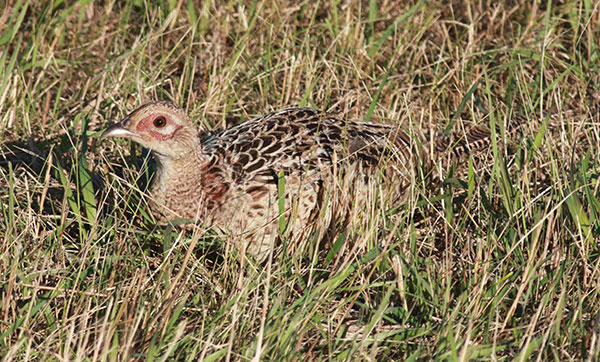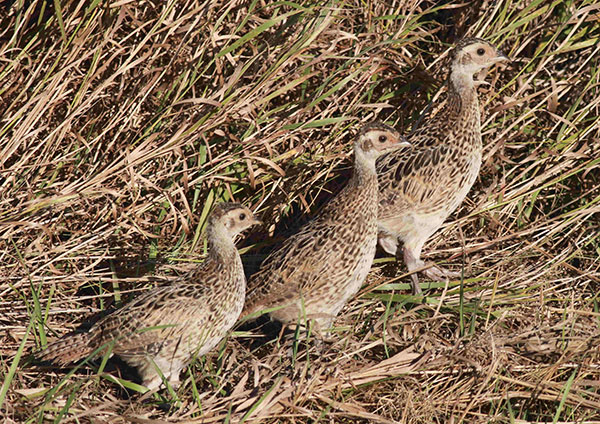
One of several orioles that visited Paul’s feeding station last Monday.

A female Ring-necked Pheasant trying to “hide” with a minimum of cover.

Half of the female’s brood of fledgling Ring-necked Pheasants.
|
A welcome sight indeed! The first thing I noticed at my feeding station after lunch Tuesday was a male Baltimore Oriole – it worked its way into position past the cut orange halves and nectar feeder to taste the grape jelly feeder. Perhaps the orange halves served their purpose by attracting the oriole initially, but it opted for the jelly, as did a series of females and first-fall orioles during the following hour, and periodically through the afternoon, which made it especially fun to see the loose flock that apparently stopped over for some hours – but not an orange feather to be seen since.
Wednesday, something I’ve never seen before was apparent family group of five American Kestrels actively hunting, one with prey in its talons. All five mini-falcons were within a 50 feet area of roadway, occasionally taking a relatively slow gliding flight to the ground, or hovering a moment then returning to a perch. In retrospect I wished I had spent more time observing the group – I meant to do a quick return, but got sidetracked a little farther down the road. I did return the following day, but was a bit disappointed not to find them when I checked out the area – but I knew that when birding, we must operate in the moment, ‘cuz with birds, things can change in an instant, much less in 24 hours.
My first 45 minutes afield Thursday afternoon was pretty uninteresting and I was becoming a bit impatient, but about the time I thought I’d take a quick return trip home, a hen pheasant caught my eye next to the road. As I approached her, she laid down in the grass, showing how easily she blended into her surroundings even though there wasn’t much cover for her. She provided a pleasing photo, but I knew there must be some young’uns at hand. That’s when I caught some motion closer to my position as six three-week-old fledglings broke cover and followed the female’s lead to the edge of taller grass, again showing their cryptic coloration. I’m not sure why the grass in this area was dry, considering other grass was vibrant green and growing daily; but it worked well to show the cryptic colors of the female and her brood.
So that episode helped to fire me up a bit, and when I returned to the Red-headed Woodpecker photo site, I decided to stop a while to see if the adults would oblige me with some interesting behavior, revealing actions, or a photo op. I was quickly rewarded by a beautiful adult that brought a big bug to the photo snag that turned out to be a big beetle. It tore into the bug and swallowed the pieces and, thankfully, instead of leaving the striking woodpecker made a half-circle around the snag and took a bit of an interest in me as it looked for its next insect prey at the same time.
The opportunity to photograph, and just to view the remarkable blazon red head and breast, and the lively beauty of this feathered animal gave me yet another fulfilling photo opportunity and shared time with this species. After a couple months, you’d think I might tire of it, or its affect might be dulled at least a little – but no, these birds are just so exciting and inspiring. And next week, this pair might fledge their second brood of the season.
On my way home, I observed an adult Krider’s Red-tailed Hawk; it was pretty scruffy looking due to its on-going molt. Driving into the setting sun, just as the road bisected a deep wetland I mistakenly thought a dozen American Avocets were just regular ole Franklin’s Gulls until they flushed before me and I realized my mistake. I was left planning for a return the next day – it’s just four miles south of home. Then, just a mile south of my house I was surprised by a beautiful fledgling Krider’s Red-tail, but I misjudged the trust of this raptor that took flight pre-maturely and provided only a couple documentary photos. Again, maybe it will be around tomorrow. But like the kestrels, these gems offered no second chances.
Friday, I was surprised to find another young Cooper’s Hawk not far to the north, but a big adult female Ferruginous Hawk was the best sighting of the day – kind of a late season find a month after most Ferrugs separated from nesting territories. It was quite a distance northwest of home (60 miles as the hawk flies), but right in the middle of the Missouri Coteau – the primary nesting landform for Great Plains Ferruginous Hawks.
It was raining and cool Saturday through Monday, so I didn’t check my usual areas of avian action, but Monday evening I did see the three Snow Geese feeding on the edge of a flock of Giant Canada Geese about a quarter-mile south of my office. These three summer stopovers will be joined by big flocks of Snows and other Arctic-nesting geese in about five weeks. In the meantime, there will be plenty of exciting birding reports to share! I hope the weather is better in your home range – Enjoy.
Article and photos by Paul Konrad
Share your bird sightings and photos at editorstbw2@gmail.com